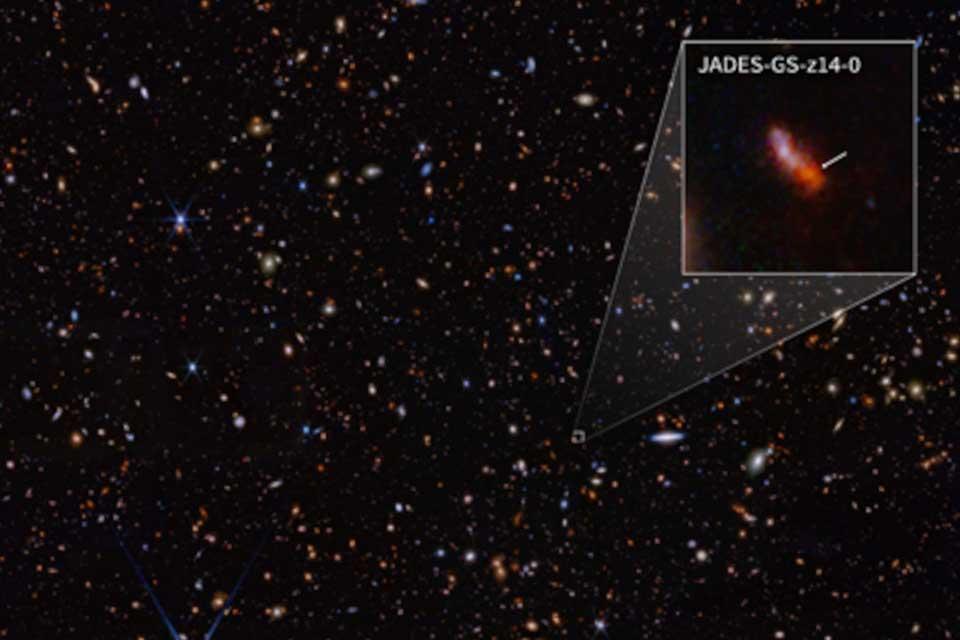The discovery of the most distant galaxy yet seen was announced today by an international team, with Oxford astronomers playing a key role. The observations came from the James Webb Space Telescope (JWST), the successor to the Hubble Space Telescope, which successfully launched on Christmas Day 2021.
Since then, JWST has been surveying the Universe out to unprecedented distances. The JWST Advanced Deep Extragalactic Survey (JADES) team made the latest record-breaking discovery of a galaxy called JADES-GS-z14-0 in the constellation of Fornax.
'The key evidence that we have found the most distant object comes from its spectrum, where we spread the light out with wavelength,' explains Professor Andrew Bunker of the University of Oxford, who is on the Instrument Science Team for NIRSpec and is a founding member of the JADES team. 'We used the Near Infrared Spectrograph (NIRSpec) on JWST to show that the wavelengths of the light from this galaxy had been stretched out by a factor of 15 by the expansion of the Universe, showing it is enormously distant.'
Dr Alex Cameron, a postdoctoral researcher at Oxford responsible for choosing targets for the JADES team, adds: 'Our team had identified this galaxy as potentially being very distant through its very red colours in very sensitive images from the NIRCam camera on JWST, which made it a great target for spectroscopy with NIRSpec.'
'This galaxy is seen when the Universe was only 290 million years old – meaning that we are looking back in time 98 percent of the way back to the Big Bang,' adds Dr Aayush Saxena, a postdoctoral researcher at Oxford and member of JADES. 'The photons left this distant galaxy well before the Sun and Earth formed.'
JADES member Dr Jacopo Chevallard, a postdoctoral researcher at Oxford who used the spectrum to measure the age and number of stars in JADES-GS-z14-0 explains: 'One puzzle is that this record-breaking galaxy, the earliest yet seen, is brighter than expected. It is a challenge to have that number of stars form so early in the history of the Universe.'
'The detection of this galaxy really shows the power of JWST,' continues Dr Gareth Jones, fellow postdoctoral researcher on the team at Oxford. 'By taking one of the most sensitive observations ever in the infrared (or light with longer wavelengths than the light that our eyes can see), we are able to detect light that has been travelling for an extreme distance, and discover one of the first galaxies to form in the Universe.'
The discovery paper from the JADES team, led by Dr. Stefano Carniani of the Scuola Normale Superiore in Pisa, was posted on the arXiv preprint server this morning, and has been submitted to the journal Nature.

This infrared image from NASA’s James Webb Space Telescope (also called Webb or JWST) was taken by the NIRCam (Near-Infrared Camera) for the JWST Advanced Deep Extragalactic Survey, or JADES, program. The NIRCam data was used to determine which galaxies to study further with spectroscopic observations. One such galaxy, JADES-GS-z14-0 (shown in the pullout), was determined to be at a redshift of 14.32, making it the current record-holder for the most distant known galaxy. This corresponds to a time less than 300 million years after the big bang.
In the background image, blue represents light at 0.9, 1.15, and 1.5 microns (filters F090W + F115W + F150W), green is 2.0 and 2.77 microns (F200W + F277W), and red is 3.56, 4.1, and 4.44 microns (F356W + F410M + F444W). The pullout image shows light at 0.9 and 1.15 microns (F090W + F115W) as blue, 1.5 and 2.0 microns (F150W + F200W) as green, and 2.77 microns (F277W) as red.

Credit: NASA, ESA, CSA, Joseph Olmsted (STScI). Science: S. Carniani (Scuola Normale Superiore), JADES Collaboration.
Web Links:
- Paper: https://arxiv.org/pdf/2405.18485 “A shining cosmic dawn: spectroscopic confirmation of two luminous galaxies at z∼14” Stefano Carniani et al. (the JADES Collaboration)
- Space Telescope Science Institute news item: https://webbtelescope.org/contents/early-highlights/nasas-james-webb-space-telescope-finds-most-distant-known-galaxy
- NASA blog post: https://blogs.nasa.gov/webb/

